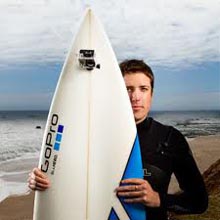Startups
The Worlds Newest Billionaire – GoPro’s Inventor Nick Woodman

When Nick Woodman developed the GoPro camera, he had no idea that the brand would one day make him a billionaire. What was special about this lover of adventure sports that made him a highly successful entrepreneur? Was it just about being lucky, about being at the right place with the right product at the right time, or were there other qualities that went into the making of this new billionaire?
Read on to see how a brilliant mind’s ability to recognize opportunities in ordinary life situations and translate them into great business ideas made all the difference.
Nick Woodman – The New Innovative Billionaire
The GoPro story:

GoPro cameras manufactured by Nick’s company Woodman Labs are very useful gadgets for adventure sports enthusiasts like surfers and skydivers. These high quality video cameras can be worn by the user in several different ways. They have the ability to shoot high quality video footage or still photographs at predefined intervals. The fact that popular nature channels like National Geographic and The Discovery Channel make use of GoPro cameras speaks a lot about the quality, utility and popularity of these products. Felix Baumgartner used several GoPro cameras during his supersonic record-breaking skydive from a height of 39 kilometres.
Foxconn, the manufacturer for several reputed products such as the Sony Playstation and the Apple iPhone recently bought 8.88% stake in Woodman Labs for $200 million. The valuation of Woodman Labs thus works out to about $ 2.25 billion.
Nick being a majority stake holder, owns at least 51% of the company and that means his net worth is at least $ 1.15 billion. Let us take a closer look at the qualities of this new billionaire.
A need becomes an opportunity:
 Nick first got the idea about a camera that could be worn by the user in the late 1990s. However, he began thinking about it more seriously while on a surf trip in Australia with a few friends in 2002. It was a great trip with several memorable moments, but sadly it was impossible to take quality pictures of those wonderful moments.
Nick first got the idea about a camera that could be worn by the user in the late 1990s. However, he began thinking about it more seriously while on a surf trip in Australia with a few friends in 2002. It was a great trip with several memorable moments, but sadly it was impossible to take quality pictures of those wonderful moments.
A friend with a camera on the beach could hope to get a few stills, but from the distance they were a far cry from the type of pictures which would befit those thrilling moments. A wearable camera is the solution, but the only options available in those days were disposable waterproof cameras. Apart from poor results, they were neither comfortable to wear nor easy to use.
That trip finally made Nick translate his idea about the wearable camera into a serious project – GoPro. A chance event allowed Nick to see the need and that paved the way for a great opportunity. Most people on the other hand are not likely to take notice when these opportunities present themselves. You will see this ability of spotting opportunities and generating ideas in action in many other places in Nick’s success story. Take a look at how the brand name GoPro was coined.
Naming the brand:
In the days before GoPro cameras became available, only a professional surfer was able to get quality photographs of themselves in action. These photos were taken by a photographer who went out into the water with the surfer. When amateur surfers experienced great moments, they would often wish from the bottom of their hearts that they could go professional just to have those moments recorded. That gave Nick the idea for the brand name GoPro, something he thought that most surfers would identify with and he was bang on target. The idea that the camera made the wearer feel like a hero gave the model its name – Hero.
Product development:
Initially Hero was only a wrist camera. Nick’s enthusiasm for racing gave the next big idea for further development of the product. A Hero camera strapped to the roll bar of a race car came back with some amazing footage. Nick realized that GoPro should not restrict itself to wrist worn cameras and that it should be possible to wear it in many different ways and be mountable on equipment.
Checkout Nicks new invention, the GoPro Hero3:
Project funding:
Can belts made of shells and beads pay for the starting capital of a billion dollar company? The way Nick Woodman got the idea for generating the starting capital for his company is as amazing as the rest of his story and once again demonstrates his ability of finding opportunities in situations where most people would see nothing of importance.
Behind every successful man is a strong woman. One day while on a surf trip to Bali,Indonesia, Nick’s girlfriend Jill (now his wife) came back to their place wearing a nice looking belt made from shells and beads. It looked much better than the price she paid for it. Nick seized the opportunity and bought 600 of those belts which he later sold for a neat profit in about two months time. That was how the starting capital for GoPro was raised.
Product development:

The first model was a 35 mm film camera capable of taking still pictures. Next came the 10 second digital video camera without audio capability. The 3 mega-pixel cameras which could take both still pictures and video footage with audio and save them to a memory card was a major improvement. From then on it was one innovation after another and today with the right Hero camera you can record professional quality HD video. You get all this in a lightweight product that costs only a few hundred dollars.
One of the things that we should all learn from Nick is the hunger for innovation. He has a long list of innovations in line for his products, and the next step will be a dual Hero camera that can record the action in 3D. It is expected to take the product into an entirely new level and it is likely to hit the market in a few months.
The hunger for success:
Nick said at an interview that he was confident about the success of his business when his first camera model generated a revenue of $ 2000 at his very first trade show. When you are looking for success, you should not think about failure. If you want to learn swimming, you should never think about drowning. This quality is essential to keep fears and doubts in control and stay on the track to success. Nick showed ample evidence of this quality and according to him, the thought of failure never crossed his mind. Sometimes not having any clue about the future is a boon in disguise for the entrepreneur.
A few great shots taken on a GoPro camera:




The story of Nick Woodman, this year’s new billionaire and his brand GoPro reads like a book which demonstrates the key ingredients for success. It shows how the ability to find opportunities in ordinary situations in life together with some great ideas and constant innovation take people to great heights. Luck is always good to have, but as the saying goes, fortune favors the brave.
Get your hands on a GoPro HD Hero2 Outdoor Camera
Article By Joel Brown | Addicted2Success.com
Startups
How to Manage Your Startup’s Finances More Efficiently
No matter how groundbreaking your product or service, your startup could quickly be on shaky ground without proper financial management

Running a triumphant startup requires juggling numerous responsibilities. From managing operations and coordinating with team members to developing innovative marketing strategies and nurturing relationships with clients, the to-do list seems endless. (more…)
Startups
5 Strategic Power Moves to Successfully Build Your Empire
Transitioning from idea to empire is a journey of strategic planning, execution, and constant evolution

The journey from a fledgling idea to a thriving empire is both exhilarating and daunting. The Startup Launchpad is not just a process but also a strategic framework that enables visionary entrepreneurs to become market leaders. This framework comprises five power moves, each a critical steppingstone in building a successful business.
These moves—Ideation, Business Plan, Online Presence, Strategic Marketing, and Launch and Growth—are the blueprint for turning aspirations into achievements. (more…)
Startups
How to Avoid Startup Clichés and Buzzwords When Pitching Investors
Using jargon can make you sound like you’re trying to fill space instead of providing meaningful data

Entrepreneurs frequently seek startup funding through a variety of channels. Yet, none seem as challenging as successfully pitching to experienced investors. After all, investors are pressed for time and eager for opportunities. These characteristics make it challenging to motivate them, especially if you’re bombarding them with a pitch full of jargon. (more…)
Startups
From Idea to Empire: 5 Power Moves for Your Startup to Thrive in Today’s Market
As an entrepreneur, I’ve learned that understanding market dynamics and choosing the right business model are crucial

As an entrepreneur, I’ve learned that understanding market dynamics and choosing the right business model are crucial.
A few months into the startup, I was quick to gauge why it is necessary to go beyond the nuances of operational efficiency and the art of sustaining a business amid growing competition.
Collaboration is key.
The HR and the recruiting teams work with departments to foster a culture of collaboration, but what’s indispensable to business performance is the sync between the marketing and sales teams. What we’d consider as entrepreneurs is the need to ensure seamless collaboration to predict and achieve business goals together. In turn, this will help secure long-term recurring revenue for the business.
Besides, entrepreneurs need to focus on revenue as they gear up to take their startup from $0 to $1 million. The journey is filled with critical decisions, from identifying your target customer base to choosing the right funding strategy.
So, what next?
Read on… because here are five practical, results-driven strategies that you as a founder can implement to make a mark in their industry.
#1. Embrace the Lean Methodology
What is lean methodology?
It is all about pivoting resources to create more value for customers with fewer resources.
This principle encourages you to be more agile and allow rapid iteration based on customer feedback rather than spending years perfecting a product before it hits the market.
Want to implement it?
Here’s what you can do.
Build “Measure-Learn” Loop: What I did was develop a minimum viable product (MVP), a simple version of the product. You can do the same since it allows you to start the learning process as quickly as possible. After launching MVP, measure how customers use it and learn from their behaviors and feedback.
Here’s what I can recommend here:
- Identify the core features that solve your customers’ primary needs and focus solely on those to develop your MVP.
- Know the feedback channels where early users can communicate their experiences, suggestions, and complaints.
- Analyze user behavior and feedback to make informed product development and iteration decisions.
#2. Focus on Customer Development
Let’s talk about taking our startup to the next level.
It’s not just about getting customers – it’s about really getting to know them. We need to dive into their world, understand their struggles, and see how our product or service can make a difference in their lives.
It’s like we’re detectives, piecing together the puzzle of our business hypothesis by actually chatting with our customers
What would you ideally do here?
Understand Customer Segments: I’d say, start dividing your target market into segments and develop a deep understanding of each segment’s demographics, behaviors, needs, and pain points. The idea is to get into their shoes and really feel what they feel.
Ensure your Product Clicks: When starting up, think of what you offer and consider whether it clicks with what our customers need. My thought was “Does my product solve their problems? Does it make their day better?” Put yourself through a tough grilling session to show customers the value proposition and ensure that the product’s promise matches what our customers are looking for.
I’d recommend the following actions here:
- Talk to them – through surveys, interviews, or even casual chats. The goal? To gather real, raw insights about what they need and expect.
- Use the collected data to create detailed profiles for each type of customer. This way, everyone on our team really understood we were serving. I think this should help your startup as well.
- Try out different versions of our product with a few customer groups. It’s all about feedback here – understanding if you’re hitting the mark or if we need to pivot.
#3. Foster a Data-Driven Culture
The digital world is highly data driven since it fuels key decisions in a startup.
I believe it’s essential for us to build a data-driven culture. This means, you’ll move from making decisions based on hunches or assumptions. Instead, the focus should be on data analytics and insights to guide our strategies and improve our outcomes.
What can you do?
Use Data Analytics Tools: You should be using these tools to gather, analyze, and interpret data related to customer behavior, market trends, and our business operations. Here, consider the adoption of pipeline forecasting that leverages AI to find patterns in marketing data.
In turn, you’ll get areas for improvement since it can analyze historical data and predict the outcome for you to plan your.
Action Items:
- Pinpoint key performance indicators (KPIs) that align with your business objectives and ensure they are measurable and actionable.
- Next, you can consider training your team to understand and use data analytics tools. This might involve workshops or bringing in experts to build a data-savvy workforce.
- Once everything is in place, regularly review data reports and dashboards. This gives us a clear picture of a startup’s health and helps adjust your strategies and predict future trends.
#4. Strengthen Your Financial Acumen
A good grip on financial skills is important to steer your business towards growth and making sure it stays on track. For this, you’ll have to understand the money side of things, which helps you manage your cash flow. Think of figuring out smart investment moves and sizing up any risks that come your way.
Here’s a tip on how you can get savvy with your finances.
Maintain Rigorous Financial Discipline: I’m really focused on cultivating a strong company culture, one that truly resonates with our mission. So, I’d suggest fostering open communication and encouraging a sense of ownership and collaboration among everyone in the team.
Action Items:
- Get to know your financial statements inside out – I’m talking about the income statement, balance sheet, and cash flow statement. These are like the vital signs for your business’s financial health
- Use financial forecasting that helps predict your future money moves. With this, you will have a heads-up on upcoming revenues, expenses, and how much cash you’ll need. Also, research on the available financial forecasting tools that can make predictions spot-on.
- Don’t go at it alone. Regularly touch base with financial advisors or mentors. With them by your side, you’ll have a fresh perspective on your financial strategies to ensure you’re on the right path to hit your business goals.
5. Prioritize Team Building and Leadership Development
It is crucial to focus on building a solid team and developing strong leaders. This means putting our resources into the people who are going to propel our company forward.
What you’ll aim for here?
Creating a culture where everyone collaborates and every team member has the chance to emerge as a leader.
What I would do:
Cultivate a Strong Company Culture: This culture should mirror our mission and foster open communication. It’s important that it encourages everyone to feel a sense of ownership and work together.
Invest in Leadership and Team Development: As founders, we’ll have to make way for opportunities for teams to enhance their skills, face new challenges, and grow in their careers.
Some concrete steps that you should consider taking:
- Begin with clearly communicating your startup’s vision, mission, and values so that every team member is on the same page.
- Conduct regular team-building activities and workshops to boost skills and strengthen a sense of unity and collaboration.
- How about starting a mentorship program within our organization? The more experienced team members could guide and support the growth of newer or less experienced folks.
- Alas… encourage feedback at all levels. We should keep striving to create an environment where open, honest communication is the norm and everyone feels safe to speak up.
I know it’s one thing to get your head around these ideas and quite another to actually make them a part of your everyday business life. But that’s where the real magic happens, right? It’s all in the doing.
As a startup founder, this means more than just being a big dreamer. How about rolling up your sleeves to be the planner who pays attention to the smallest details. Ultimately, these tips and more tactics around it will help carve a leader in you who listens and cares and the learner who’s always ready to adapt
So, as you’re either starting out or moving forward on this entrepreneurial adventure, keep these practical tips right there.
May these be your guiding lights, helping you steer through the wild and exciting world of building a startup that’s not just a dream, but a thriving reality.
-

 Success Advice3 weeks ago
Success Advice3 weeks agoHow to Choose the Best Affiliate Programs for Your Blog
-

 Entrepreneurs4 weeks ago
Entrepreneurs4 weeks agoThe Mindset Shifts Required to Become a Successful Online Entrepreneur
-

 Success Advice4 weeks ago
Success Advice4 weeks agoThe Power of Ethical Leadership: How Integrity Drives Success
-

 Entrepreneurs3 weeks ago
Entrepreneurs3 weeks ago6 Hacks to Boost Your Productivity as a Business Owner
-

 Entrepreneurs3 weeks ago
Entrepreneurs3 weeks ago5 Important Legal Tips Every Entrepreneur Should Know
-

 Startups2 weeks ago
Startups2 weeks agoHow to Manage Your Startup’s Finances More Efficiently
-

 Entrepreneurs2 weeks ago
Entrepreneurs2 weeks agoBuild a Strong IT Team with These Smart Hiring Tips
-

 Entrepreneurs2 weeks ago
Entrepreneurs2 weeks agoHow Entrepreneurs Are Harnessing LLCs to Launch Successful Startups































9 Comments